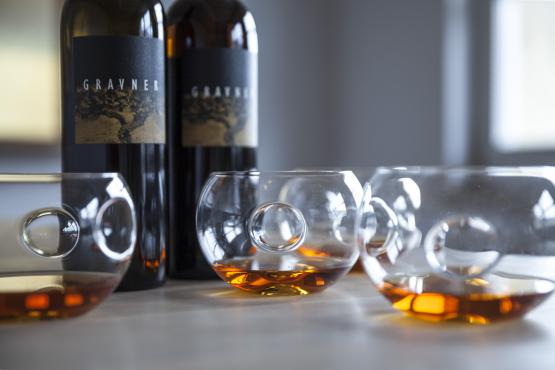
Orange Wine (excerpt)
3 min read
Ever wondered why, in Renaissance paintings, the white wines in people’s glasses don’t look as translucent as the whites of today, and why they look more orange than anything else? This isn’t a trick of the light or the patina of age, but perhaps because the Michelangelos of this world actually drank orange wine.
Today, most white wines are made by pressing grapes, separating off the juice and discarding the skins, stems and pips to produce a wine that is pale in colour. If, instead, the juice is left to macerate and ferment on its skins, pips and possibly stems (just like red wine), you end up with a wine that looks orange – or any of a variety of hues ranging from yellow to luminous orange, or even amber and shades of rust.
While a seemingly new trend, orange wine is ancient – as the country of Georgia, with its claim to 8000 vintages, can attest. Believed to be the birthplace of wine, this tiny country in the foothills of the Caucasus, wedged between Russia, Azerbaijan, Turkey and Armenia, has been making wine in the same way for thousands of years using large clay pots buried deep underground. Wine is a huge part of daily life there and most people know someone who grows grapes and makes wine at home. While there are of course regional differences in winemaking techniques used across the country, what they don’t do is use a completely different vinification system for whites compared to reds. Instead their whites are made using the whole berry rather than just the run-off juice, since the grape skins, pips and stems impart all sorts of antioxidants, oils, tannins (and of course pigment), that help protect the young, fermenting juice from oxidation. Squeezed juice is much more fiddly to work with given its susceptibility to oxygen, so it is perhaps unsurprising that when wine was first created, all wines – regardless of colour – would have been made in broadly the same way.
Georgia aside, orange wines are still pretty rare. Excellent examples exist in places as diverse as Sicily, Spain and Switzerland, but the main hotbed of production is undoubtedly Slovenia and the neighbouring Italian Collio, where the most profound examples of this style of wine can be found.
Orange wines are likely to be some of the most unusual wines you’ll ever taste. Forget fresh, zesty flavours of the sort you’d find in a zippy sauvignon blanc, these golden whites feel a lot weightier and broader in your palate. Some of my personal favourites marry nutty notes with a touch of orange blossom, and are deliciously moreish.
Although sometimes confronting, the best examples are soulful and complex, featuring unexpectedly novel combinations of flavours and textures. The most curious aspect is their tannic intensity. During skin contact, tannins are extracted, giving these hybrids the texture (tannins, antioxidants et al) of a red. Taste them blind, or in a dark glass, it is hard to know which side they bat for.
Try them alongside food and they come into their own, becoming highly addictive. Tannins soften, even disappear, and the versatility of their extraordinary flavour profile becomes apparent. They are real foodie wines which may explain their renaissance on the food scene in London in recent years. They work well with a wide range of dishes but are particularly suited to robust flavours like mature, hard cheeses, spicy stews or even better, walnut-based dishes. They also seem to show their best out of large glasses as they need plenty of air in order to open up and show their full personalities. The key is to treat them more like reds than whites, and not to drink them too cold.
___________
Excerpt from the book Natural Wine: an introduction to organic & biodynamic wines made naturally by Isabelle Legeron MW. Reproduced with the kind permission of CICO Books.



